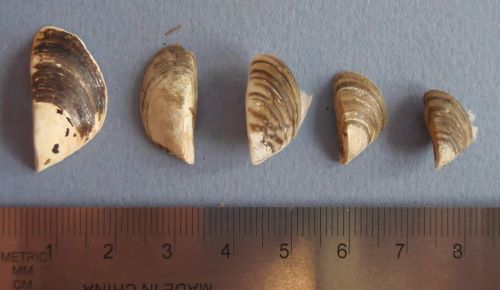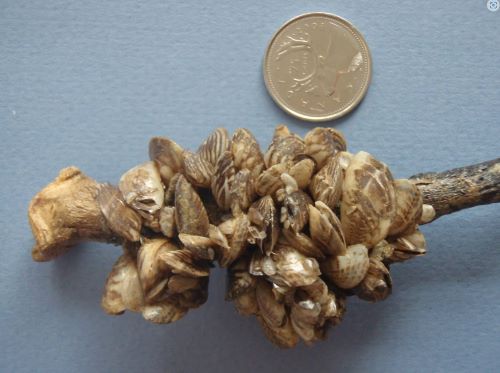Measuring less than 2.5 centimetres (one inch) in length, non-native zebra and quagga mussels are dwarfed by B.C.’s native freshwater mussels. The size of these tiny critters is deceptive, though. They pose a serious threat to the province’s freshwater fisheries and infrastructure, with an estimated potential economic impact of $43 million per year were they to become established in our lakes and rivers. While they haven’t yet been found in B.C., our government is working hard to keep it this way.
What are zebra and quagga mussels?
Zebra mussels (Dreissena polymorpha) and quagga mussels (Dreissena rostriformis bugensis) are from the Baltic Sea region. They were first introduced into North America’s Great Lakes in the 1980s via transoceanic ships. Since then, they have slowly made their way westward, and can now be found in 24 U.S. states. In Canada, they have been found in Quebec, Ontario and, most recently, Manitoba.
What makes zebra and quagga mussels particularly sinister is their ability to reproduce at an alarming rate, and survive weeks in a merely moist environment without being submerged in water. Compared to native mussels, they are small and can be hard to detect, especially in the early stages of life. The free-swimming mussel larvae are microscopic, and can also survive for long periods of time. Free-standing water left in the bottom of a boat, for example, is a prime location in which the larvae could be transported.


Why are zebra and quagga mussels a problem?
Like many invasive species, zebra and quagga mussels are hard to remove once established. They can attach to hard surfaces such as boats, propellers, and fishing gear, meaning they can be easily transported from one waterbody to another. It also means they can attach to pipes and other infrastructure, clogging systems and causing serious and expensive damage to B.C.’s hydropower and agricultural irrigation. There are concerns the mussels could degrade the quality of drinking water and disrupt the freshwater ecosystem, displacing native fish like sockeye salmon. The follow-on effects for the recreational and commercial fishing industries could be huge. All these factors contribute to making these species serious threats to B.C.
What is being done to prevent the spread?
The Province has been conducting early-detection monitoring and active-prevention efforts through public outreach and education campaigns since 2015 as part of the Invasive Mussel Defence Program.
Mandatory watercraft inspection stations are operating at the southern and eastern borders of the province. The B.C. Conservation Officer Service has a team of specialized inspectors at the stations checking and, if necessary, decontaminating watercraft being transported into B.C.
What can you do?
It is mandatory to stop at the open inspection stations if you are transporting watercraft in B.C. so that government officials may perform inspections. Non-motorized watercraft like canoes, kayaks, car-toppers, paddleboards, and inflatable boats must also be inspected. Failure to stop at an open inspection station could result in a $345 fine.
Always follow the Clean Drain Dry procedure for your boat, trailer, and fishing gear before entering another waterbody:
- Clean off plant parts, animals, and mud from boat and equipment (e.g. boots, waders, and fishing gear). Use a power-washing station if available.
- Drain onto land all items that can hold water (e.g. buckets, wells, bilges, and ballast).
- Dry all items completely before using them in another body of water.
Author: Jessica Greinke, Freshwater Fisheries Society of BC